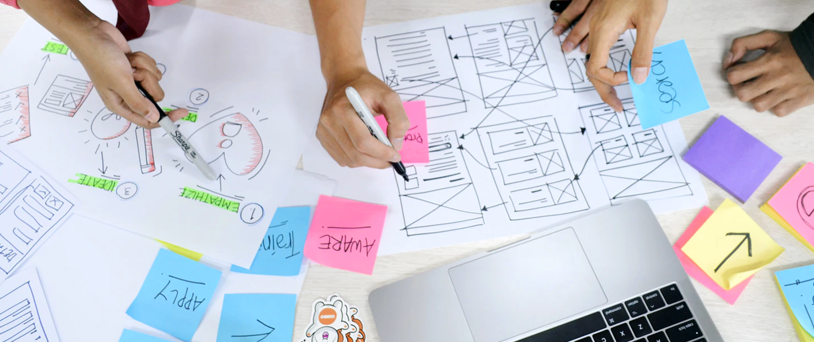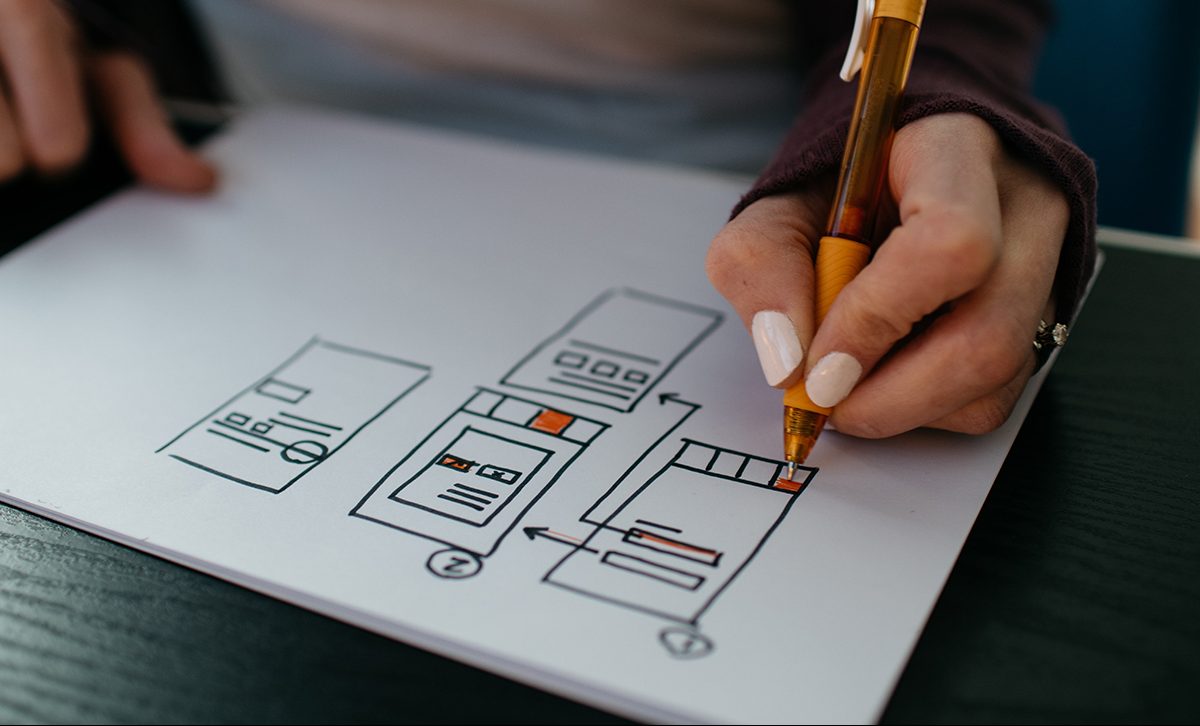
As a leading Digital Creative Agency, our team is always striving to find the right balance in the fusion of creativity & technology which, by their very essence, can often live in parallel worlds. Add to this an underlying passion to deliver industry-leading UX (find out more about why User Experience is so important) and there’s a recipe ripe for success or failure at the hands of process.
Creating a harmonious balance between UX and Agile methodology is a challenge our team relishes everyday in an effort to deliver wonderfully simple results for our clients better, faster, more cost-effectively and with bigger impact.
What is Agile Methodology?
As a leading technology solutions provider, Wonderful has adopted Agile Methodology. Agile is said to have formed during the 1970s, with Dr. William Royce being cited as one of the leading heads behind compiling the methodology. Royce published a paper that discussed the managing and developing of large software systems, outlining his specific ideas about sequential development. In this, Royce stated that a project could be developed much like a product on an assembly line, whereby each phase of the development had to be complete before the next phase could begin. These phases of work are known as ‘sprints’ (a term undoubtedly familiar to those working in software and technology development), and each sprint is usually restricted to a 2 or 3-week time limitation. Agile Web Development is actually a broad category of methodologies based on the principles outlined in the Agile Manifesto, which was compiled by a team of developers in 2001 and includes Agile Scrum Methodology; Lean Software Development; Kanban; Extreme Programming (XP); Dynamic Systems Development Method (DSDM); & Feature Driven Development (FDD).
Agile grew out of the experience with the real-life projects of leading software professionals from the past, enabling the process to discard the challenges and limitations of traditional development (experienced with Waterfall/Spiral processes). Developers adopted the concept that software and/or web development shouldn’t be an entirely sequential process as outlined by Royce as far back as the 1970s, as there are always unexpected bugs as well as new technological hurdles to overcome, not to mention the science behind anticipating user demands. In modern times, it’s much easier to collect user feedback in real time with tools like heat-mapping and scroll/click/tap-tracking, so we have an inherently greater understanding of how people interact with websites and apps, aligning even further with this iterative agile approach. The benefits of Agile are many, including: an incremental approach; the ability to pivot and change direction based on customer and stakeholder feedback; and short timeframes that help to keep the team focused.
Subsequently, the Agile Method has been widely accepted by the industry as a best-practice solution for project management and development, one which Wonderful adopts today. Of course, this is vastly simplifying the process, and Agile has since evolved into a field of expertise in it’s own right, one which our project management team are well-versed and qualified in.
The rigid structure of Agile is rather a dichotomy of User Experience Design, a traditionally waterfall-based approach. So, how can digital agencies make it work?
Delivering great UX in an Agile world:
As aforementioned, Agile Methodology is inherently focused on developers, having grown out of programmers’ attempts to solve common issues experienced during development projects. The ‘Agile Manifesto’ has not strictly ever included UX, or the time, resource, and research that UX professionals need in order to create excellent user-centric designs. With the Agile sprint principle, the team focuses on one block of features for a 2-week period and then moves on. As a result, the design team are traditionally under huge pressure to create, test, refine, and deliver their work at an almost unfeasible pace, and with little of the context required to deliver consistent, user-centered experiences. In fact, in the original Agile framework, the role of UX/UI was not even clearly defined and developers were actually responsible for the UI. However, creating the UI of an application without having any prior knowledge, data, insight or understanding of the user’s needs (or stakeholder requirements) can result in a woefully ill-designed user experience.
In order to achieve harmony between the UX process and the Agile environment, we ensure engagement from all relevant parties from the very beginning. Everyone involved with a project from key stakeholders and decision-makers; to content creators; to IT & tech specialists should meet during the early stages of development so that everyone agrees upon the overall goals. This is where our Pre-Discovery and Discovery Day Workshops form a vital role in any project. Though it may seem tedious at first, having everyone on the same page from the start saves time by reducing the need for superfluous emails, phone conversations, and meetings throughout the development cycle, freeing up more time for practical execution and iteration. As all members of the team (both internal and external) are engaged from the beginning, what may have taken 4-8 months to finish in a more traditional waterfall approach, can often be accomplished in just a few weeks with Agile.
In a traditional, non-iterative waterfall process, we would break our projects down into 4 phases:
- Think (Discover)
- Look (Design)
- Make (Develop)
- Achieve (Test)
Adopting UX into the Agile framework, and vice-versa, requires a little more than early and unanimous engagement. To ensure great user experience is delivered through everything Wonderful produces, we have had to make UX more than just a discipline within one team, it has to underpin and have an impact on almost everything we create. It is this level of UX maturity which enables the team to understand that UX is not just a ‘lick of paint’ and visual finessing, but more of an all-encompassing approach to everything from strategy, features & structure, to interaction, content & aesthetics. In this scenario, rather than bringing the UX designers into a project when user journeys and features/functionality have already been decided upon by the rest of the project team, they are an integral part of the discovery process from the beginning to determine how these things should work (with an eye on the aesthetic as a function of experience, not just “making it look nice”) culminating in the entire team (both agency and client) having a shared vision for the project.
This then bleeds into the iterative approach of Agile methodology, enabling UX designers to factor in testing and refinement far beyond quantitative A/B testing. In the early stages of some of our most recent user-centric projects, the UX team have been able to undertake more qualitative research through surveys and real-world user testing to maximise the impact of design decision making, rather than relying on behavioural data from current website performance and intuition or assumption from stakeholders, which can often be fuelled by confirmation & causality bias.
Time is always a challenge:
One key struggle many development partners and agencies face is to fit UX into agile practice – UX is not a one-off task, it is a continual and developmental process which includes a range of stages such as research, ideation, prototyping/wire-framing, user testing, and iteration. The hurdle here is fitting this into a ‘box’ of an agile sprint (or multiple sprints) of just two to three weeks.
We may overcome this by ensuring that not only are our UX designers an integral part of the initial discovery phase, but that much of their practical deliverables are typically undertaken one sprint ahead of developers. We also do not consider UX a ‘one sprint’ task, rather it is an underpinning and a consideration at all stages of the development process.
What does this look like in real-terms?
According to an article by Paige Laubheimer for NN Group, UX and Agile can work in harmony when:
- The business understands and supports UX work, bringing it into the process at the earliest stage of discovery – something Wonderful advocates as a fundamental principle.
- The UX team display leadership and spend time on outreach with colleagues – something which we undertake not only in scrums but in internal workshops and user-testing.
- The Agile workflows are flexible enough to accommodate the needs of the UX – in fact, UX underpinning everything we produce maximises this effect.
- UX people are part of the product teams, where they can build respect and rapport with developers – our collaborative approach truly lends itself to this being able to add value to every project we deliver.
This is certainly abundantly true in our adoption of UX into the Agile workflow process and we truly believe this fusion is demonstrated in our work for clients.
10 Tips for creating UX & Agile harmony:
From a survey of 125 professionals from the USA and Singapore, including UX designers, developers and project managers, 10 tips to help deliver UX success within agile processes emerged:
- Allow time for release planning and story mapping.
- Conduct UX activities ahead of the sprint.
- Cultivate a collaborative culture.
- Think iteration, not perfection.
- UX team to participate in the scrums.
- Turn user research into team-driven events.
- Secure strong stakeholder engagement.
- Set explicit roles and responsibilities.
- Host training and onboarding sessions.
- Modify your method until it works.
Bringing a UX focus to your next project:
Through explaining the adoption of UX practice into Agile Methodology as a fundamental part of the Wonderful Process, this article has hopefully demonstrated how a user-centric approach to projects can live in harmony with agile delivery, despite their seemingly mismatched characters. If this sounds like an approach your business needs to apply to your next technology development project or digital campaign, please feel free to get in touch to discuss your brief.
Latest posts

The Art of Human-Centered Design: Wonderful Strategies
Human-Centred Design is a problem-solving approach that explores the needs, behaviours, and experiences of users at every stage of the design process, creating digital products that are fundamentally people-orientated – a methodology that combines real data with creativity to develop solutions that are not only functional but also intuitive, meaningful, and aligned with user expectations.

Accessibility in UX: Designing for All Users

The Wizard of UX
Exploring the role of wonder, play and innovation in creating memorable online experiences. Uncovering the tricks behind not only getting users to their desired destinations but also how we make the steps in getting there pleasurable. What role does wonder play in these interactions and, when we know the end goal, how can we reverse-engineer wonder into the process to ignite curiosity and captivate users?